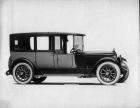|
Lubricant for Ball & Trunnion uni
|
||||
|---|---|---|---|---|
|
Home away from home

|
The '51-54 Service Manual (Section XX) states the lubricant for front 'uni' (actually a ball & trunnion slider on Ultramatic equipped '51's) must be 2oz. of 'Heavy Fiber Universal Joint Lubricant'. On diagram there it specifically states 'Do Not Grease' so certainly looks like ordinary grease is not to be used.
Would appreciate suggestions please about where to get the heavy fiber lubricant, or what a worthy substitute would be. One blog I saw suggests Alemite CD-2 Wheel Bearing Lubricant but the specs for that are vague, so I'm not sure if it would be suitable.
Posted on: 2013/10/14 16:41
|
|||
|
1951 Packard Club Sedan | [url=ht
|
||||
|
||||
|
Re: Lubricant for Ball & Trunnion uni
|
||||
|---|---|---|---|---|
|
Home away from home

|
If you really think you need it you can make it yourself at home. They might as well have said - cheapest wheel bearing grease available.
CRC makes one called short fiber drum brake wheel bearing grease that you can also buy at NAPA. It's not a high temperature application and any NLGI #2 EP will outperform the original.
Posted on: 2013/10/14 19:14
|
|||
|
||||
|
Re: Lubricant for Ball & Trunnion uni
|
||||
|---|---|---|---|---|
|
Home away from home

|
Thanks O-D, Tim. Sounds like you're saying that grease technology has come a very long way since 1951! I was concerned that Packard had said use only heavy fiber lubricant and not your ordinary grease.
Just to satisfy my curiosity - there are two schools of thought: one is that actual fibers such as cotton were added to lubricants back then (to help 'draw' the lubricant around working surfaces); and the other was that the 'fiber' aspect was simply the characteristic of the lubricant when stretched between surfaces (- it formed 'strings'). I wonder which was correct?
Posted on: 2013/10/15 6:03
|
|||
|
1951 Packard Club Sedan | [url=ht
|
||||
|
||||
|
Re: Lubricant for Ball & Trunnion uni
|
||||
|---|---|---|---|---|
|
Home away from home
|
I don't recall seeing any fibers in the old style wheel bearing grease. The characteristics of the grease was it was thick and made a fiber looking appearance when worked. At least this is what I remember.
(o{}o)
Posted on: 2013/10/15 10:55
|
|||
|
We move toward
And make happen What occupies our mind... (W. Scherer) |
||||
|
||||
|
Re: Lubricant for Ball & Trunnion uni
|
||||
|---|---|---|---|---|
|
Forum Ambassador

|
If you stick your finger into my can of old-style heavy fibre grease and pull some out, it certainly comes out stringy and one could easily call it fibrous, though it's not clear to the eye if it actually contains fibers. It's extremely viscous and stringy, not at all like modern greases. How relevant that is to the application is unknown to me. I only use it for the ball & trunnion joint and use the Mobil product I mentioned earlier for wheel bearings.
Posted on: 2013/10/15 11:15
|
|||
|
||||
|
Re: Lubricant for Ball & Trunnion uni
|
||||
|---|---|---|---|---|
|
Home away from home

|
I think it works like this:
a) go to the grocery store and buy a can of Draino (NaOH) b) next go to the butcher counter and get a pound of suete (beef fat) c) dump into a pot and boil. d) pour off the gylcerine e) add 85-90 SUS mineral oil and stir Viola! You are now in the refining business. All you need to push the product are some soft and fuzzy cartoon characters and predatory staffers. Of course what comes from the oil companies is a lot better, but the above process will do for your conestoga wagon, your flax wheel, and your windmill. What you get from this is a stringy amber colored grease. Below is the actual formula from a 1932 handbook Universal Joint Grease Sodium Tallow Soap 9.0 - 10.5% Free Tallow Oil 1.5% Max. Free Alkali as NaOH None Moisture 2.5% Max. Mineral Oil 85.5 - 87% (85-90 SUS at 210F) Penetration Unworked 310 - 330 at 77F ASTM D-217 Mineral Oil Flash Point 370F Min. Mineral Oil Flash Point 410F Min. I'm sure if you took this to the local meth lab they would have no trouble cooking it up. PS: either SAE 40 motor or 85-90W gear oil will work.
Posted on: 2013/10/15 11:57
|
|||
|
||||
|
Re: Lubricant for Ball & Trunnion uni
|
||||
|---|---|---|---|---|
|
Home away from home

|
Thankyou for the additional comments gentlemen. I now know the way forward, plus I have a basic knowledge of 'grease production', and can make my own if ever there is a shortage of the stuff!
Posted on: 2013/10/15 17:30
|
|||
|
1951 Packard Club Sedan | [url=ht
|
||||
|
||||
|
Re: Lubricant for Ball & Trunnion uni
|
||||
|---|---|---|---|---|
|
Home away from home

|
Have seen the fibrous type grease referred to as sodium soap grease.The stringy texture is the grease itself.
Posted on: 2013/10/18 1:03
|
|||
|
||||
|
Re: Lubricant for Ball & Trunnion uni
|
||||
|---|---|---|---|---|
|
Home away from home

|
Yes Rusty - after a lot of research I have come to the conclusion the 'fibres' you might see are just the strings made by stretching the grease.
Posted on: 2013/10/19 17:42
|
|||
|
1951 Packard Club Sedan | [url=ht
|
||||
|
||||








